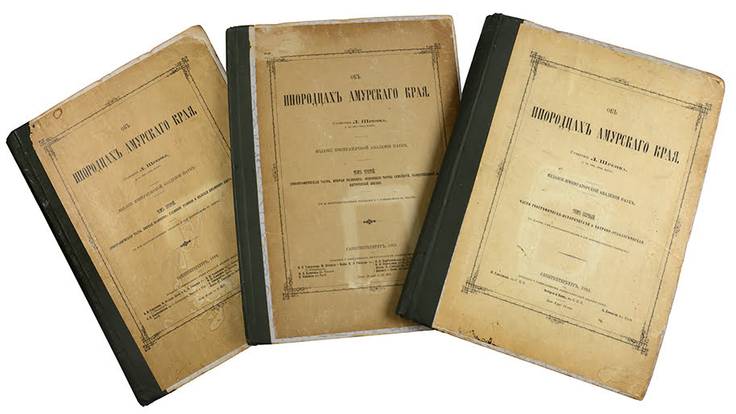Об инородцах Амурского края [On the Indigenous People of the Amur Region] Publication: Imper. Akad. Nauk, Skt. Peterburg, 1883, 1899, 1903. Fresh example of this uncommon work containing extensi...
Lot 308
1 5001 700
Publication: Imper. Akad. Nauk, Skt. Peterburg, 1883, 1899, 1903. Fresh example of this uncommon work containing extensive research into the ethnography of the indigenous peoples of Eastern Siberia. Richly illustrated, it is the first work to look in detail at the ethnic composition of the Amur population and scientifically describe the differences in appearance, culture and language of the different peoples of the region. Leopold Schrenck (1826 - 1894), a geographer and ethnographer of Baltic German origin, was a member of the St. Petersburg Academy of Sciences from 1865. Between 1854 and 1856 he headed a scientific expedition to Amur and Sakhalin. The materials he collected during this trip formed the basis of his several scientific works, the earliest published in German under the title Reisen und Forschungen im Amur-Lande (in 4 vols., St. Petersburg, 1858-1900). The present Russian work is a truly unique record of a culture that had already started to disappear by the time of Schrenck’s expedition, as a result of Russia’s active colonisation of the region. Schrenck supports his own observations with extensive material from earlier research, such as that of Fischer, Müller and Georgi. Schrenck captures every aspect of life among the Amur peoples – their language, costumes, culture, hunting and trade methods, and their religious practices and beliefs. He draws comparisons between гиляки [Giliaki], аины [Ainy], тунгусы [Tungusy] and other peoples populating the region. Importantly, Schrenck also looks at the historic Chinese, Japanese and Russian influences on the region. The third volume of the work, concerning religious beliefs and ceremonies, was published after Schrenck's death based on his notes and drafts from the expedition. The Amur region is situated in the south west of Russia and shares a border with China in the South. The region was in fact part of China until 1858, when it was passed to the Russian Empire as a result of Aigunskiy agreement between the two countries. Rare on the market: we could not trace any copy offered at auction in the past 30 years. Description and Bibliographical references: Three volumes, 4to. (32.5 x 25 cm). XII, 323 pp., with colour lithopraph map, 9 plates; XX, 314 pp. with 36 plates, including 11 in colour; XVII, 145 pp., with 25 plates, including 1 in colour, all plates engraved after Nikolay Dmi- triev-Orenburgskiy. Contemporary green cloth over paper boards, original wrappers pasted on upper boards; slightly rubbed and spotted.


